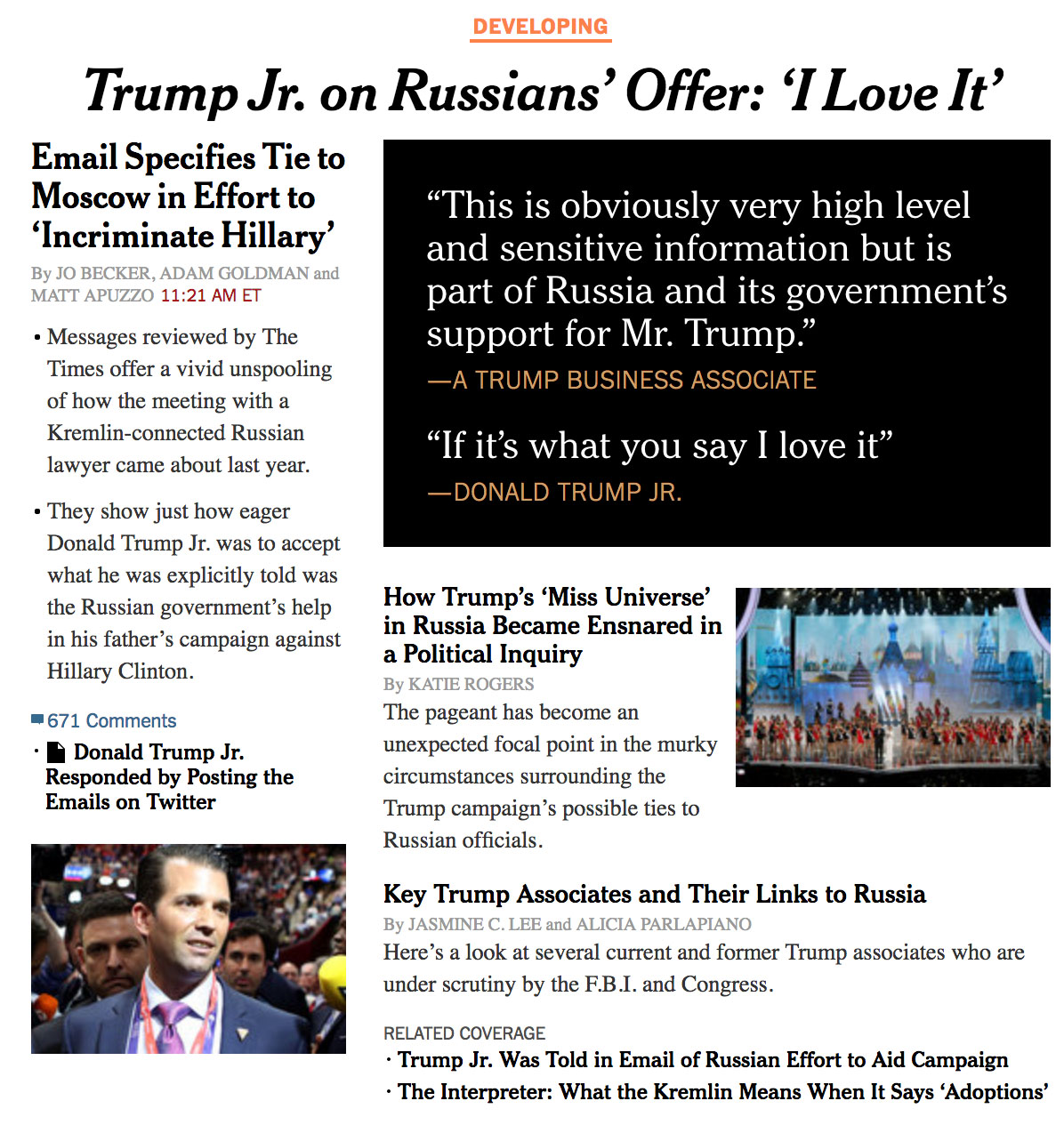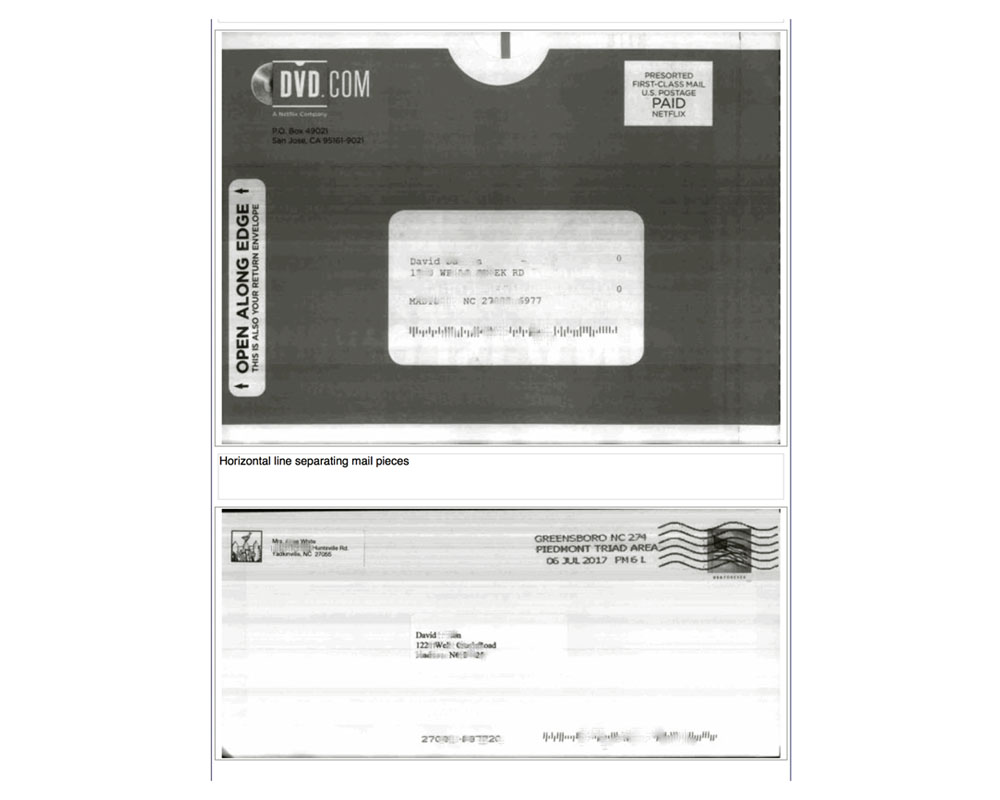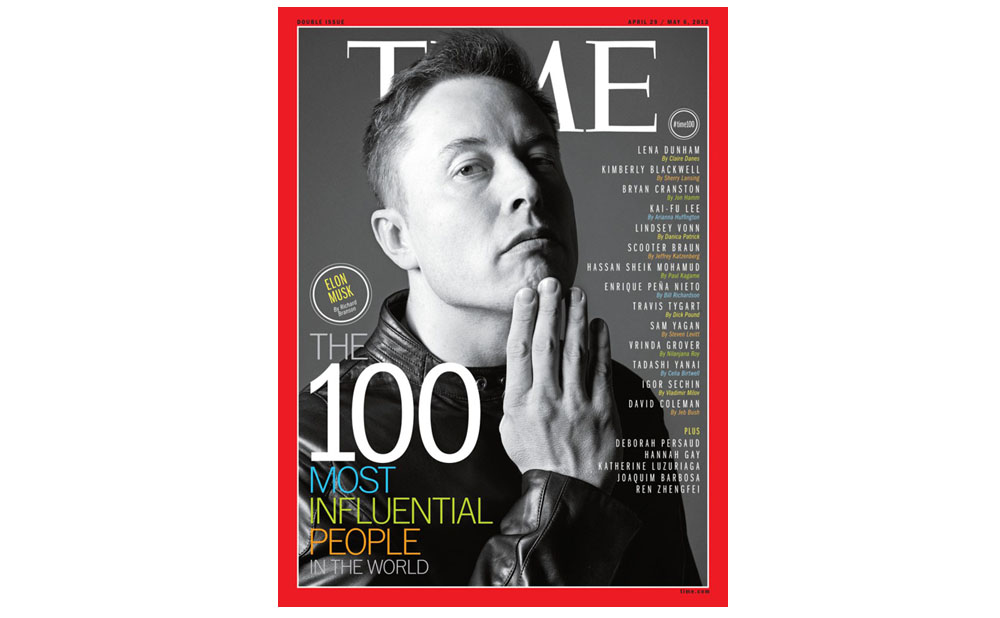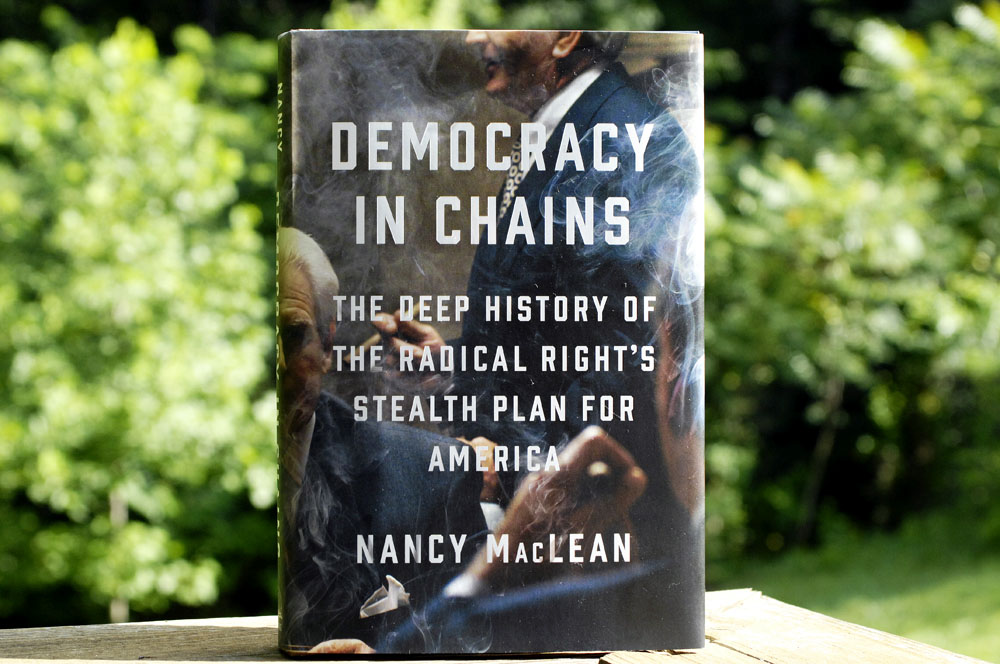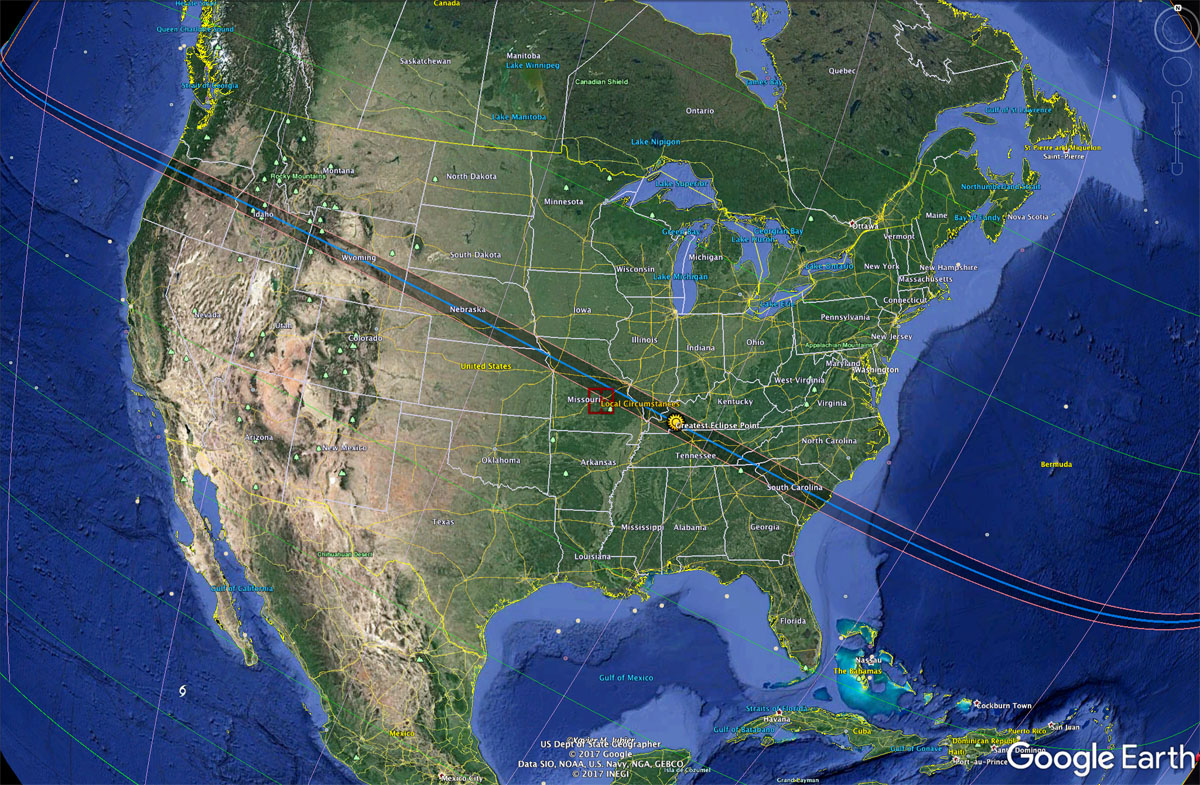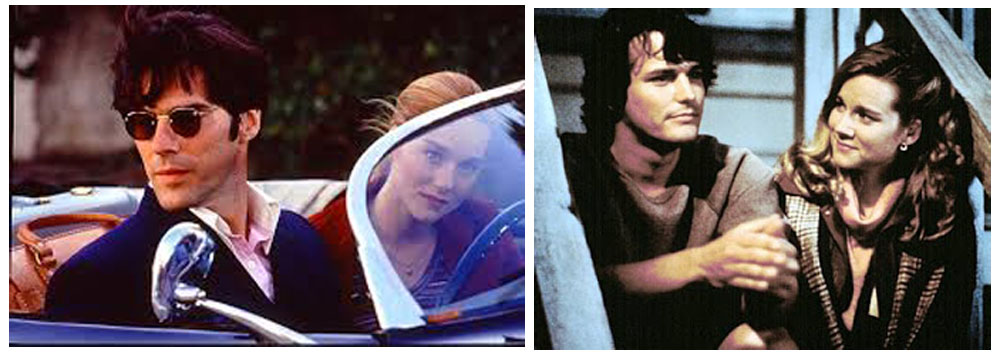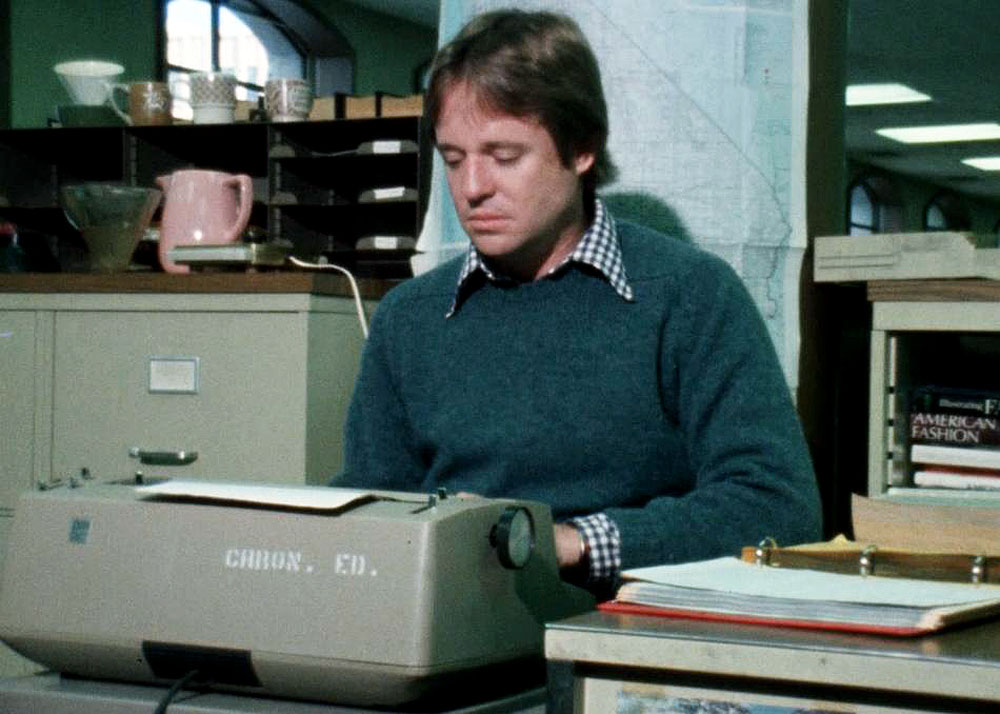I got a good look at the resident twins and their mama yesterday while they were snacking in the back yard. Everyone looks very sleek, healthy, and well fed. The rainy spring has been very good for all the wildlife. I have never seen so many lightning bugs.
A great feast of reckoning is coming

Don Jr. and Eric Trump, during their now-gone days of gloating
They thought that they could get away with it. With the presidency and the executive-branch bureaucracy in their hands, with both houses of Congress, and with a stolen seat on the Supreme Court, it looked like a slam-dunk to them.
They’d have all the power they needed to never be found out and brought to justice. They’d be able to make deals with the Republican party to enact the entire right-wing agenda — vast new riches for the rich; new miseries for the old, the poor and the sick; a deregulatory ax to any kind of restraint on exploitation, whether of disempowered people or of the earth; Orwellian levels of lies and deception along with a mewling media too weak and demonized to challenge it; more dumbing down of the masses, from the first grade to the universities; ingenious new laws to lock all of this in place even when a strong majority rose up against them; a pool of white trash brownshirts in the flyover lands, always angry and primed for violence; blow jobs and a cut of the tax money for the white preachers; perpetual degradation and a life of fear for godless liberals and all the others they hate; ever crueler courts, as they continue to stack the courts; new powers for right-wing state governments; more prisons — prisons that even turn a profit; a new international alignment playing kissy-kissy with kleptocracies (and kleptocrats) while insulting people-oriented democracies (and their leaders); unrestrained American corruption on the Russian model; and an American democracy crushed and looted, like Pinochet’s Chile.
Though we are still not out of the woods, with luck we may have just passed the point at which the tables have turned.
The New York Times has turned the tables during the past four days with an ever-tightening noose — a noose of treason — around the neck of Donald Trump Jr. Actually, though, the noose was not made by the New York Times. Rather, the noose was made by whoever supplied the brilliant sequence of leaks that have forced Donald Jr. to incriminate himself ever more deeply with each day’s new leak. So far there have been four days of leaks about the meeting at Trump Tower on June 9, 2016. But we may not be done yet. Young Trump, according to the emails revealed by the Times, was delighted at the prospect of getting some dirt on Hillary Clinton from Russian operatives. With that dirt, they’d be able to stampede the media, bamboozle the voters, enrage their base, and make Sanders supporters hate Hillary as much as Republicans did. We don’t yet know whether they tampered with elections systems, though we do know they tried. They’d be able to say (and say, and say, and say) that they’d won the election. Therefore they’d have had themselves a masterpiece worthy of a narcissistic crime family — a legal coup. Apparently they are so narcissistic that Donald Senior even boasted about Russian help, as though it never occurred to him that justice could ever catch up with a Trump.
And it’s not just Donald Jr. whose neck is in a noose. This is going to be a wholesale hanging. Jared Kushner also was at the meeting, as was Paul Manafort. This morning, the Palmer Report reported that ProPublica has recovered an old tweet that reveals that Reince Priebus, then chairman of the Republican National Committee, was at Trump Tower on the morning of the meeting. So it seems likely that the Republican party was in on the treason, too. Donald Senior denies knowing anything about the meeting or the conspiracy, but if you believe that, then I have a big building or two in New York to sell you, if you don’t mind the underwater mortgages.
Now we wait for the wheels of justice. We liberals are used to that. We know all too well that the wheels of justice turn slowly, and we know all too well who it is who always tries to break the wheels of justice. Because it’s always the same damned people.
Just think how they gloated after the election. Remember how they taunted us? Are they gloating now? How well do you suppose they’re sleeping? How paranoid do you suppose they are about which piece of the story is going to be revealed next?
And so, unless they are somehow able to head this off, then the same democratic institutions in Washington that have stopped them before will stop them again. Government. No wonder they hate it.
But that’s just Washington’s justice, and that’s not justice enough. Almost 63 million Americans voted for this. Some already regret it. Some never will. To them, the biggest shit show in American history promised to make us strong again. And the most depraved character in American politics — ever — looked presidential. That is deeply pathological. It’s terrifying. The Republican party enabled it (and is still trying to head off justice).
Because I live in the sticks, I am acutely aware of another matter of justice and of holding people responsible for what they have done. As I have said before in this space, anyone who voted for Donald Trump has forfeited the right to be called a decent human being. We have to figure out how to handle that. Speaking strictly for myself, I am not willing to ever forget it.
Informed delivery??
Back in April, the U.S. Postal Service rolled out a new feature called “Informed Delivery.” If you sign up for it, then each morning you’ll receive an email from the postal service with a scanned grayscale image of each piece of mail that is to be delivered to you that day.
I wasn’t aware of this until I picked up a promotional leaflet about it while I was at the post office today. My first reaction had to do with privacy. Obviously they’re taking pictures of every single piece of mail that passes through the post office.
After a little Googling, I learned that the post office has been taking pictures of all the mail since the 1990s. It’s part of the address-scanning and automatic sorting process. But just think what they can do with that. Not only do they have pictures of all the mail, but they also can cross-reference all the addresses and feed a database that documents who knows whom, and who does business with whom. In other words, there is no private way of communicating with anyone anymore — not by telephone, not through email, and not through the post office. You can be sure that it’s all in a database somewhere, indexed, cross-referenced and retained.
Privacy questions aside, what might Informed Delivery be good for? I live about a quarter of a mile from my mailbox. It actually would be nice to know in advance what, if anything, is in the mailbox before I go out to retrieve the mail. I don’t necessarily go to the mailbox every day. But yeah, I signed up for it.
In its promotional material on Informed Delivery, the postal service says that they hope it will make the postal service seem more relevant to millenials, since millenials’ lives apparently revolve around their smartphones. And apparently, for those who have signed up for the service, it’s popular. The postal service says that almost 80 percent of the people who receive the daily emails look at them. (You do know, don’t you, how businesses can tell whether you opened a piece of mail?)
It seems the postal service will also try to use it for marketing. Companies that send mail will be able to pay the postal service for little ads that will be displayed in the daily emails, when something the company has mailed is scheduled to be delivered that day. Direct marketers are trying hard to figure out how to leverage that.
In any case, now we know that someone has pictures of all the mail we’ve received since sometime in the 1990s. We can assume that the mail can be searched by name and address, and we can assume that they can build lists of everybody we’ve ever sent mail to or received mail from. We also should assume that the mail can be cross-referenced to telephone calls and emails. Keep in mind that, as you drive each day, particularly in urban and suburban areas, your license plate is frequently scanned by roadway cameras, and thus your car can be tracked. Your cell phone is a tracking device. And of course they have, or at least have access to, a database of credit card transactions. What you do with your computer is tracked.
It is better to be aware of these things than not to be aware. And I think it’s better to monitor the ways we’re monitored than not to. Normally all that stuff is stored, and ignored, in vast databases. But when they want to build a dossier on someone, just think how much they’d know.
Here’s a thought experiment. If you wanted to communicate with someone at a distance in a way that could not be monitored and that would not leave a record, would you be able to do that? If so, how?
Update:
I got my first Informed Delivery email this morning. Here’s what it looks like — a DVD from Netflix’s DVD division, and what appears to be an invitation to an elementary school reunion. It’s kind of cool, actually, because now I know that I need to go up to the mailbox today and retrieve the DVD.
Some speculations on Whole Foods
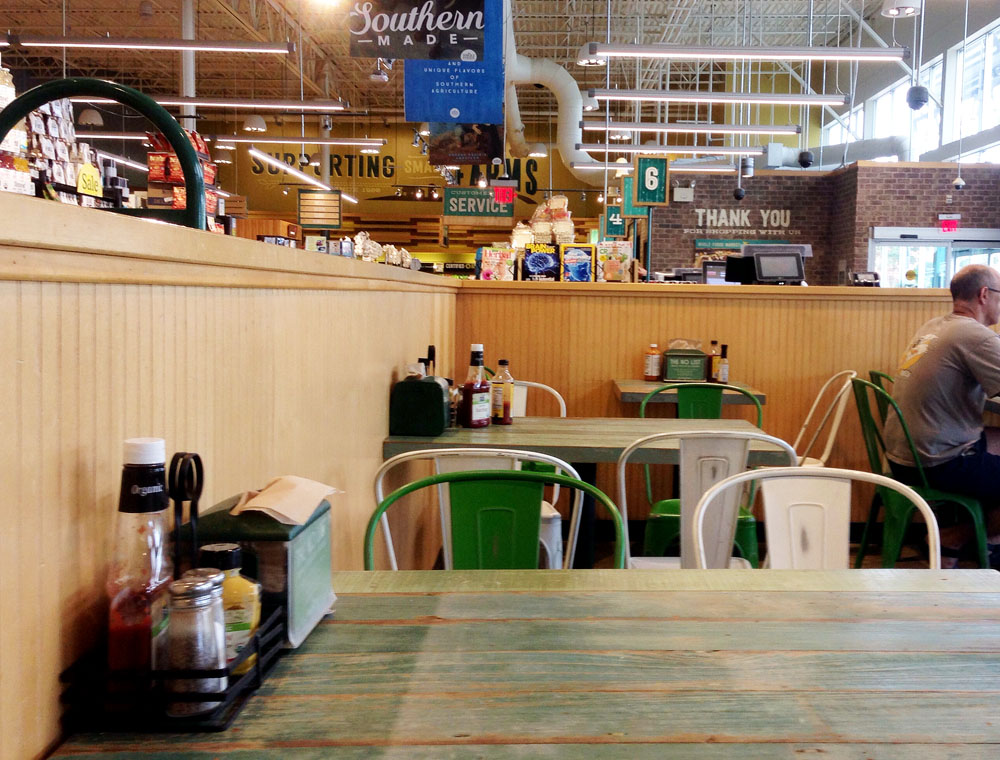
Whole Foods Winston-Salem, before the lunch rush
It’s interesting how much buzz there has been about Amazon buying Whole Foods. Even people who’ve hardly ever been inside a Whole Foods and who don’t use Amazon (people like my brother) have been talking about it. Everyone seems to suspect that this transaction may be the leading edge of big changes in how all of us shop.
At the Winston-Salem Whole Foods earlier this week, I said to the checkout guy, “What do y’all think of your new owners?”
I got a somewhat testy response that I interpreted to mean that Whole Foods employees have gotten tired of answering questions. No doubt many of the questions are hostile. He responded as though I had asked what’s going to change. Apparently that’s the question most people are asking. Anyway, his testy response was that he has no idea what it all means, that he’s not on the board, doesn’t get to sit in on the meetings, and has no idea what it’s all about. Ouch. Perhaps he also was expressing a bit of nervousness. After all, some of the stories that have been written about Amazon buying Whole Foods have speculated that checkout people will soon be replaced by machines. Note to Amazon PR types who came across this through Google Alerts: You need to communicate with Whole Foods employees and reassure them, if you can. They may be freaking out.
I’ve read a good bit of the commentary on this. Everybody is speculating. The liberal media — for example Salon, or Vox — have a strong dislike for Amazon and seem to assume that Amazon will roboticize Whole Foods stores and squeeze small organic farmers into bankruptcy, to the benefit of Big Organic.
I fear they may be right on the matter of the small organic farmers who farm with a conscience, as opposed to Big Organic, which farms with the intent of taking advantage of a market in which they can get away with charging a lot more for what they sell. On the other hand, if big players can do truly good sustainable farming and grow beautiful and exuberant produce (rather than pale and inferior stuff which just happens to have an organic sticker on it), then how much of a bad thing is that? That’s all about how organic farmers are monitored and the standards they are held to. Amazon will need to be very careful about buying only from honest, well-monitored organic operations. Luckily, Amazon has the resources to do that. They’d better get it right.
However, as for roboticizing Whole Foods stores, I just don’t think that is going to happen. Certainly Amazon has roboticized its warehouses and shipping operations. But that’s all out of sight of the customer. It’s different with Whole Foods. Amazon’s PR people will make it clear to Amazon’s management (though I feel sure that Amazon’s management already gets it) that Whole Foods will now become the brick-and-mortar public face of Amazon and that they’d better make it pretty.
If Amazon wanted impersonal brick-and-mortar operations that lend themselves to mechanization and roboticization, then they’d be competing with low-end stores such as Aldi. Why buy a top-of-the-market operation like Whole Foods just to turn it into Aldi? That would be destroying a large chunk of Whole Foods’ value, the value for which Amazon paid a lot of good money.
One of the wisest commentaries I’ve read suggests that what Amazon wants is a network of delivery centers. Whole Foods has 431 stores in upscale locations. You order online whatever you usually order from Amazon (probably not groceries). And then, the next day, or maybe even later the same day, you drive to your local Whole Foods and pick up your order. While you’re at Whole Foods, you have some ice cream, or some coffee, or a pizza, or lunch. And maybe you even shop for groceries. Whole Foods stores actually devote a considerable percentage of their floor space to food, drink, and reasonably pleasant places to sit down for a while, WIFI included. Bottom line: Amazon has new options for lower-cost and quicker delivery, plus they draw a whole bunch of new customers into Whole Foods stores. Would you want all those new Whole Foods customers to have an Aldi experience? Of course not. Whole Foods stores would now be competing with Starbucks, with every retailer at the mall, with the grocery stores, and even with the local Barnes & Noble, if you’re lucky enough to have one. You can get anything you want there, and you can still paw the lettuce and sniff the canteloupes before you buy them.
It’s devilishly clever.
Would I go there? You darn right I would, if Whole Foods will spiff up and enlarge its stores, keep them teeming with cheerful and contented employees, and sell only the best of what America’s — and here I emphasize America’s — organic farmers can produce. If the new customers that came over from Costco still want a case of canned green beans or half a ton of Pepsi, then sell it to them through the warehouse delivery system, not in the holy space of the Whole Foods store. And since the Pepsi-buyers will be Trump voters who have the manners of Walmart shoppers, please design your stores so that we old Whole Foods customers can avoid the Republicans (and they us). This may be your biggest problem, Amazon. Whole Foods customers and Walmart customers don’t mix. It’s a culture war, you know.
Whole Foods has a bad habit that I’d like to see them quit. I complain about it regularly, both on the corporate web site and at the customer service desk at my nearest store. We all should complain. That’s to stop importing so much stuff. I abhor, for example, the garlic imported from South America. It may be labeled as organic, but it’s also inferior garlic — badly cured, blemished, sometimes moldy. I’d much rather buy healthy-looking garlic from Gilroy, California, that isn’t organic, if it’s obviously better garlic (as it certainly would be if it came from Gilroy).
Maybe my view of what’s up with Amazon and Whole Foods is skewed by the fact that those two companies already get most of the money I spend. If they keep their standards up and make it fun and easy, then they’ll get 96 percent of what I spend. The rest of my spending would go to the local hardware store and to the Tractor Supply where I buy organic chicken feed. One thing that is not efficient at present for Amazon Prime are heavy items that are expensive to ship — 40 pound bags of chicken feed, for example, or even four-pound bags of cat food. Local pickup would change the economics of Amazon Prime.
Ultimately, I wonder if there isn’t something sustainable in a one-stop supply line. All those thousands of retail stores and big box stores (and the driving to and fro) suck up a huge amount of overhead and energy — and time. As long as the delivery system is efficient and sustainable (and involves far fewer cardboard boxes — the bane of Amazon Prime) then maybe it wouldn’t be an all-bad example of creative destruction.
I am cautiously optimistic.
Rich young creeps and their creepy visions
What is it about young tech billionaires that makes them so creepy?
Partly, I’m sure, it’s the character flaws that they seem to have in common — hubris, arrogance, the assurance of superiority that goes along with their being very smart and having made themselves very rich. They also see themselves as visionaries who have been anointed to lead us all into a brave new techno-utopian future brought about by the consumption of their products (and in which, coincidentally, they will be even richer). They also tend to be monomaniacs: Their idea is the one true master key to our exciting utopian future.
Why is it that their visions of the future almost always make us gag?
Just yesterday, I came across a link on Facebook to an article in Wired magazine with the headline: “Why you will one day have a chip in your brain.” Thanks for the heads-up on that, Wired magazine.
Remember Google Glass? Back in 2013, a tech blogger wrote this about Google Glass: “According to Google CEO, Sergey Brin, Google’s latest product innovation is meant to end the social isolation of smartphones as you often miss the events going on around you while playing with your phone. Google Glass eliminates that distraction as you enjoy your life while wearing glasses and have all the functions and commands of your smartphone without having to divert your attention to your phone.” Wow, Sergey. What could go wrong?
To be fair to Elon Musk, he has a broader and more mature sense of the future than do some of the lesser tech billionaires, yet he also assumes that, without the gifts that tech entrepreneurs intend to bring us, our future will be a bleak and empty one. Just recently, in talking about space exploration, he said, “There have to be reasons you get up in the morning and want to live.” Thanks, Elon. I can’t wait.
Facebook’s Mark Zuckerberg wants to bring us virtual reality, augmented reality, artificial intelligence, and a “global community” — with Facebook, of course, at the center of it. In his recent manifesto about the future of Facebook, Zuckerberg puts this line in bold: “In times like these, the most important thing we at Facebook can do is develop the social infrastructure to give people the power to build a global community that works for all of us.” Thanks for the infrastructure, Mr. Zuckerberg! And by the way, thanks for all the benefits your social infrastructure provided us during the 2016 election, particularly your focus on making your infrastructure (to use your words) supportive, safe, informed, civically engaged, and inclusive. With Facebook’s help, we’re sure on our way to building a super-duper global community!
And thanks, all you guys, for reminding me why I’m hiding in the woods.
Increasingly violent and authoritarian propaganda
⬆︎ National Rifle Association ad
⬆︎ Trump assault ad: Ladies and gentlemen, the president of the United States, talking directly to the American people
If I were a right-wing propagandist, my big concern right now would be heading off catastrophic damage to the Republican Party if (though I would say when) Trump voters see their man impeached, destroyed, and sent to prison. Many people will want to believe that it was all just a liberal conspiracy. You can be sure that the propaganda will be there to help them believe that, and, if possible, to try to use Trump’s downfall to reinvigorate rather than weaken the right-wing project and the Republican Party.
I’m afraid we’re already seeing the first pieces of this propaganda. The Trump video is crude, but the NRA video is sophisticated in its crudeness and has already been viewed millions of times. The message is clear enough: Liberals are a threat, and guns and fists are appropriate.
This is not fringe stuff, either. The NRA has about 5 million members. Trump is president of the United States, and James Mattis is his secretary of defense.
Note the anger and insult in the Mattis meme, and note how he reinforces the falsehood that the intent is to take people’s guns away, though gun control is only about keeping guns out of the hands of the wrong people, and limiting military-style wholesale-killing weapons that have nothing to do with self-defense.
More terrifying than the propaganda itself is the knowledge that this is the kind of stuff that gets results with millions of Americans.
And you know what? I’m just about sick of hearing right-wingers profane the word “freedom.”
⬆︎ An authoritarian Facebook meme
Democracy in Chains
Democracy in Chains: The Deep History of the Radical Right’s Stealth Plan for America, by Nancy MacLean. Viking, released June 13, 2017, 368 pages.
This book has been out for just over two weeks, but already there are 65 Amazon reviews. With the exception of one 2-star rating, all the ratings are either 5 stars (60 percent) or 1 star (37 percent). The 1-star reviews all cite pretty much the same talking points — that the book is intellectually dishonest, takes quotes out of context, contains inaccuracies, and that it’s a left-wing hit piece on libertarianism and one of the saints of libertarianism, James McGill Buchanan. In addition to the reviews, there many comments on many of the reviews, in which a war is raging.
The author, Nancy MacLean, is the William H. Chafe professor of history and public policy at Duke University. Libertarians can quibble over her quotes all they want, and they can say that we snowflake liberals are subject to “confirmation bias” (though libertarians never are, of course!). Nevertheless, whether I am subject to liberal confirmation bias or not, it seems clear to me that MacLean has landed what ought to be a finishing blow on the libertarian movement. It’s not that we didn’t already know what the libertarian movement is up to. It’s that MacLean’s research takes us much deeper into libertarian history and tears off the disguises of libertarian secretiveness.
MacLean begins her history with John C. Calhoun of South Carolina (1782-1850). Calhoun believed that slavery was a “positive good” that benefited both slaves and slave owners. He believed that individual human rights had to be “earned” (by becoming rich, for example) and that such rights were not bestowed by God or by mere citizenship. Calhoun clearly believed that owning other human beings was just one of his liberties, which presumably he earned by becoming rich. Calhoun was very jealous of these liberties earned by rich people, and there were pretty much no limits to his willingness to abridge the liberties of others — by force, by law, or by perversion of the Constitution) if the majority sought to constrain the power of the rich minority, even if what the rich minority wanted was to own other human beings.
MacLean picks up the Calhoun thread in the 20th Century in Virginia, with Harry Flood Byrd Sr. (1887-1966), who was a Virginia senator from 1933 until 1965. Byrd was a segregationist. He built a powerful political machine that worked for decades to try to keep Virginia segregated. Now what do you suppose Byrd’s theory of government and attitude to the Constitution might have been?
MacLean then turns to James McGill Buchanan (1919-2013). Libertarians know who Buchanan is, because they worship him. Part of the gap that MacLean is trying to close is to let the rest of us know who McGill was. Charles Koch, the second richest billionaire in America, who unfortunately has untold millions of dollars to pour into the project and the many institutions that carry water for him, helped make Buchanan’s career and helped finance the well-funded system which is using Buchanan’s strategies to make the rich richer (no regulation and no taxation), to destroy the social safety net, and to rig the rules so that rich men will have a lock on American government at every level, from now on.
Watching the eclipse
This summer — August 21 — a total eclipse of the sun will sweep across the United States. This is the chance of a lifetime to experience one of nature’s strangest events.
Unless you’re inside a path that is about 70 miles wide, you won’t see as much. A partial eclipse is not nearly as impressive as a total eclipse, because a little bit of sunlight goes a long way. Only on the path will you see a total eclipse. So, if you plan to witness the eclipse, you need to plan ahead and pick a good spot in the totality zone.
Here is a link to Xavier Jubier’s interactive Google map. This map should help you get a general idea of where you’d like to be for the eclipse. Notice that the map also will show you the percent of “obscuration” for locations outside the path.
However, for picking your location in much greater detail, I’d recommend using Google Earth. Download this Google earth file (also from Jubier), which, when opened in Google Earth, will show the path of the eclipse. Then you can use Google Earth to zoom in as close as you like to scout for locations.
A lot has been written about the danger of looking directly at the sun and why protective glasses are necessary if you want to do that. But, in the early 1970s, I witnessed a total solar eclipse in eastern North Carolina. I will never forget it. Lots of people had telescopes set up with special filters.
But looking at the sun during an eclipse is not the part that I found fascinating. Rather, the coolest part was watching how nature responds to sudden darkness in the middle of the day. You’ll want to be around lots of birds, if possible. They’ll go quiet, and as the sky lightens again they’ll start singing again. And yes, during a total eclipse it gets very dark. Not as dark as night, but spookily dark. It’s easy to understand how eclipses terrified the ancients.
Instead of worrying about glasses and filters, I’d recommend making a pinhole projector, using some white cardboard or corrugated whiteboard as the screen. With the pinhole projector (Google for how to do it), you’ll be able to see the black disc of the moon slowly moving across the sun until everything goes black. If you’re standing under a leafy tree with dappled light on the ground, you’ll see that the dappling of the light is made up of thousands of pinhole projections, in which the gaps between the leaves are the apertures. Thousands of little blurry discs on the ground will turn into crescents, because they are images of the sun.
In short, don’t look up! Instead, look around you, and listen. That’s where you’ll see (and hear) the most interesting stuff.
For an animation describing the astronomy of a total eclipse, here’s a video.
A Tales of the City revival
It had to happen, now that I think about it. Armistead Maupin let his Facebook friends know today that Variety has reported that Netflix is planning a remake of Maupin’s Tales of the City.
The books, which have sold more than 6 million copies, were first serialized in the San Francisco Chronicle and the San Francisco Examiner starting in 1978. Altogether, there were nine books in the series. There’s a list below.
Even in the early 1990s, Maupin’s books were almost too hot to touch by American television. Britain’s Channel 4 produced the first mini-series in 1993. The series was shown on PBS in 1994, but there were so many complaints about depicting San Francisco LGBT types in a positive light that PBS backed out of a second season. The series later moved to Showtime.
It was “Tales of the City” that made Laura Linney famous.
A revival of Tales of the City thrills me for a number of reasons. For one, I devoured all the books when they first came out. For two, I spent 18 extraordinary years in San Francisco, working at the same places where Maupin worked — at least before he became a rich and famous author and didn’t have to work anymore. It was at an Examiner Christmas party in 1998 that I finally got to shake Maupin’s hand and thank him for the beautiful stories that he brought into the world.
The sad thing, though, is that though Maupin invented an entirely new genre — stories about LGBT people in which they didn’t have to be miserable and die in the end — AIDS happened starting in the early 1980s, and of course Maupin had to write about that. It was a huge setback for LGBT literature, because suddenly the literature was once again about people being miserable and dying.
The books are extremely dated now, period pieces, almost kitschy. The 1990s productions would be very hard to watch now, even with the sterling performances of Laura Linney and Olympia Dukakis. But Netflix, I have no doubt, with Maupin looking over their shoulders, will find ways to bring the stories up to date so that they make sense to today’s sensibilities. And do I ever look forward to scenes shot in San Francisco with a 1970s look!
Not everyone knows that, after the first four books were serialized in the Chronicle, Maupin became irritated with the Chronicle’s editors. My old colleague at the Examiner, managing editor Pamela Brunger Scott, poached Maupin over to the Examiner, and the Examiner serialized book 5, Significant Others. After that, the Chronicle poached him back.
To me, this is huge, because the books are so dated that they make little sense to today’s young people. Because the stories seem dated now, some important history — both the history of a literature and the history of a people — was at risk of being lost. In a way, I suppose it’s good that young people no longer can relate, because it shows how much things have changed in the last 40 years. But how things used to be is something that must not ever be forgotten. These are stories which changed many people’s lives, and which changed the world.
1. Tales of the City (1978)
2. More Tales of the City (1980)
3. Further Tales of the City (1982)
4. Babycakes (1984)
5. Significant Others (1987)
6. Sure of You (1989)
7. Michael Tolliver Lives (2007)
8. Mary Ann in Autumn (2010)
9. The Days of Anna Madrigal (2014)
The Miracle of Dunkirk
The Miracle of Dunkirk, by Walter Lord. Published in the United States by Viking (1982) and in Great Britain by Allen Lane (1983). 324 pages.
Last week, in a post about summer movies, I wrote about the movie “Dunkirk,” which is to be released on July 21 and which seems sure to become a summer blockbuster. I mentioned in the post that I was looking for a good book to read on Dunkirk. I ended up with The Miracle of Dunkirk by Walter Lord.
I could not put this book down.
When I started the book, I knew nothing about the author, Walter Lord. I just now looked him up on Wikipedia. He was an American, born in 1917, died in 2002. He was an American blue blood, went to Princeton and earned a law degree at Yale. It is obvious, reading this book, that what fascinates Lord so much about Dunkirk is not the military angle, but rather the human angle, whether foible or great depth of character. The author’s sheer niceness and love of humanity somehow come through on every page, though the story is told by aggregating the memories of the men who were at Dunkirk.
Lord also wrote, in 1965, a book about the American civil rights era, The Past That Would Not Die. I do believe that Lord was a liberal, like me, and I think that must be the factor that can make a book about war so relevant. This is not a book that glorifies war or that makes little patriotic mascots out of veterans (though it treats the veterans with great respect). I believe I will read Lord’s book on the civil rights era. Obviously he is a writer who deserves to be remembered and kept in print. At least one of Lord’s books, a book about the Titanic (1955), was a bestseller. Lord was a consultant to the director who made the movie about the Titanic in 1997. I would not be at all surprised to learn that this book on Dunkirk fed into the screenplay for the new movie. I will watch the credits carefuly.
Whether or not this book was used by the screenplay writers of this summer’s Dunkirk movie, this book would have been perfect. Lord tells the story through the eyes of Dunkirk veterans, including even some Germans. Lord actually lists his cast of characters in the back of the book. The list is 14 pages long. While reading the book, I wondered how he assembled so much extraordinary detail. He explains this in the back of book with a section on source materials. Partly he relied on written reports filed with the British admiralty. But he also interviewed, and exchanged letters with, many Dunkirk veterans.
Lord’s last chapter, “Deliverance,” occurs on June 4, 1940. That’s the day that Winston Churchill delivered his “We shall fight on the beaches” speech to the House of Commons.
This book is out of print, but it can be ordered from used booksellers on Amazon. Somehow I ended up buying the British edition, though I didn’t realize it. The book was shipped by international priority mail from Goring by Sea, which is just west of Brighton. The book was delivered in nine days. It’s kind of cool, actually, that my copy of the book came from a bookshop right on the channel, not far from the action at Dover. Yup, I’ve been to Brighton, and to Dover, though I’ve crossed the channel only by the tunnel train. I have not been to Dover castle, which was used as headquarters for managing the Dunkirk evacuation. If I’m lucky enough to make another trip to England, I must visit Dover castle.


